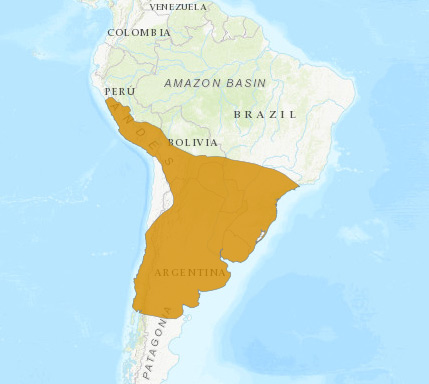Molina’s Hog-nosed Skunk
Conepatus chinga
©Mandy Paul
Taxonomy
Standard English Name
Molina’s Hog-nosed skunk
Scientific Name
Conepatus chinga
Brazilian common name/s
Zorrilho
Conservation status - IUCN
Physical Description
Like the raccoon, this species is widely used in cartoons. Its main feature is the ability to spray its enemies with a stream of pungent smelling urine over considerable distances. They are small animals, with a body length of approximately 40 cm and a tail of 20 cm. They have a distinctive colouration, with a black or dark brown coat and two white stripes running over the back of the head to the tail. The body is compact and the animal moves slowly compared to other members of the Mustelid family.
Ecology and Habitat
C. chinga has a restricted distribution and is only found in the state of Rio Grande do Sul, they mainly inhabit more open vegetation types, such as fields, avoiding the densest forests. They have a mostly nocturnal habit and during the day shelter in armadillo burrows or burrows they dig.
They are omnivores, feeding mainly on insects, small vertebrates and fruits.
They are solitary, males and females coming together only for reproduction. Gestation lasts about 60 days and results in 4 to 5 young.
Online links
IUCN redlist (http://www.iucnredlist.org) presents a synthesis of current knowledge about distribution and conservation status.
References
Cáceres, N. C. (2004). Occurrence of Conepatus chinga (Molina) (Mammalia, Carnivora, Mustelidae) and other terrestrial mammals in the Serra do Mar, Paraná, Brazil. Revista Brasileira de Zoologia, 21, 577–579.
Donadio, E., Di Martino, S., Aubone, M., & Novaro, A. J. (2001). Activity patterns, home-range, and habitat selection of the common hog-nosed skunk, Conepatus chinga (Mammmalia, Mustelidae), in northwestern Patagonia. Mammalia, 65, 49-53.
Donadio, E., Di Martino, S., Aubone, M., & Novaro, A. J. (2004). Feeding ecology of the Andean hog-nosed skunk (Conepatus chinga) in areas under different land use in north-western Patagonia. Journal of Arid Environments, 56, 709-718.
Emmons, L. H., & Feer, F. (1997). Neotropical rainforest mammals: a field guide. Chicago: University of Chicago Press.
Emmons, L., & Helgen, K. (2008). Conepatus chinga. In: IUCN 2010. IUCN Red List of Threatened Species. Version 2010.2. <www.iucnredlist.org>, , Downloaded on 05 July 2010.
Gianuca, N. (1997). A fauna das dunas costeiras do Rio Grande do Sul. Oecologia Brasiliensis, 3, .
Lyra-Jorge, M. C., Ciocheti, G., & Pivello, V. R. (2008). Carnivore mammals in a fragmented landscape in northeast of São Paulo State, Brazil. Biodiversity and Conservation, 17, 1573-1580.
Michalski, F., Crawshaw, P. G., de Oliveira, T. G., & Fabian, M. E. (2007). Efficiency of box-traps and leg-hold traps with several bait types for capturing small carnivores (Mammalia) in a disturbed area of Southeastern Brazil. Revista De Biologia Tropical, 55, 315-320.
Travaini, A., Delibes, M., & Ceballos, O. (1998). Summer foods of the Andean hog-nosed skunk (Conepatus chinga) in Patagonia. Journal of Zoology, 246, 457-460.
